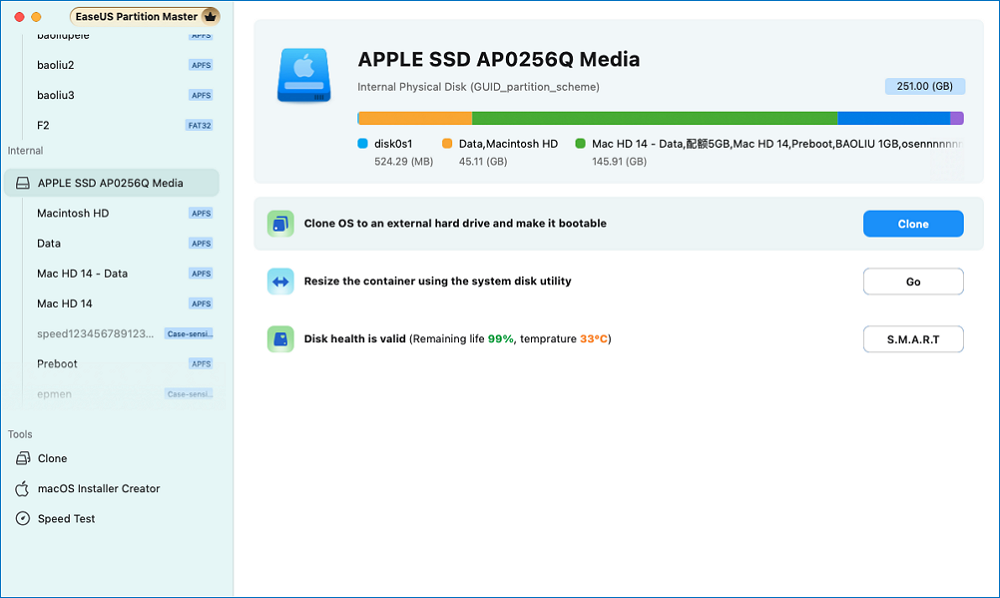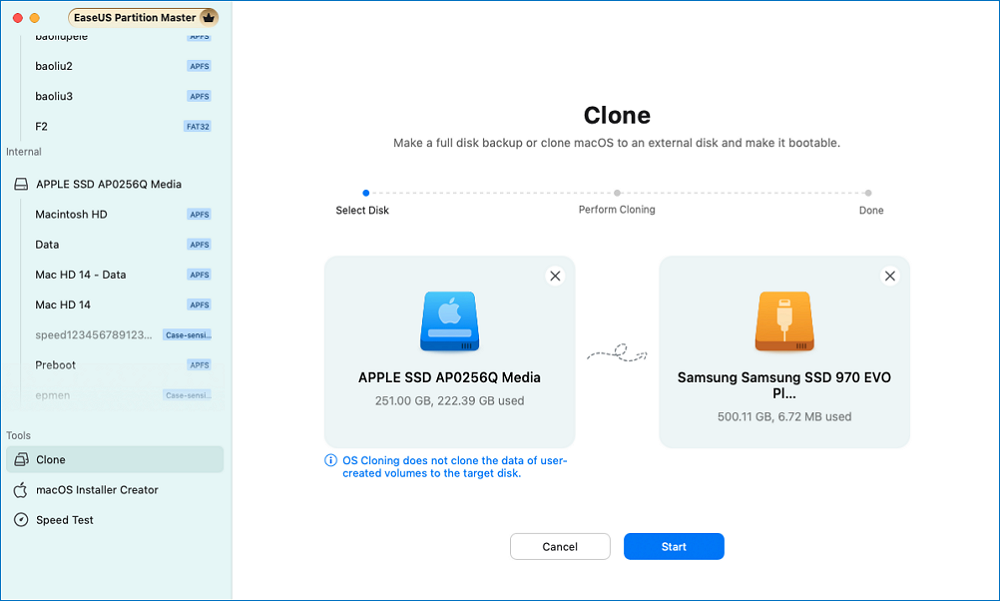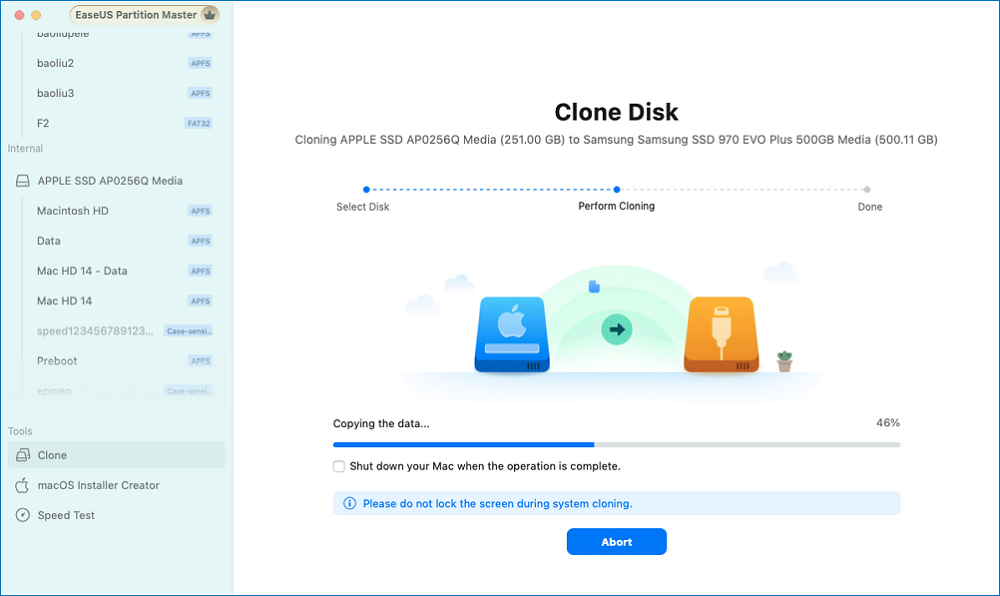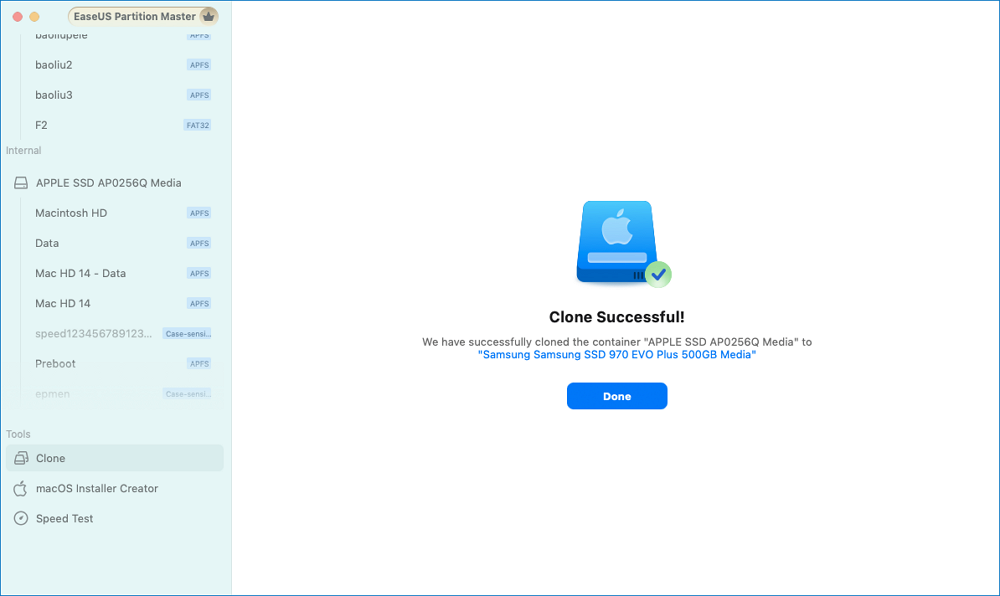Page Table of Contents
3 Ways for macOS Clone Drive to SSDHOT
Method 1: Using MacOS Drive Cloning SoftwareHOT
Method 2: Using Disk UtilityHOT
Method 3: Using TerminalHOT
ConclusionHOT
About the Author
Hot Topics
Updated on Apr 28, 2025
MacOS users looking for faster data access and better performance often upgrade to an SSD, as it is always the right way to go! Cloning your macOS drive to an SSD improves system speed, reliability, and power consumption.
Users clone disks to migrate to a new SSD, establish a backup for data security, or revive an old Mac. Three viable ways for cloning your macOS drive to an SSD meet distinct user needs.
You can easily clone your macOS drive to SSD with this step-by-step procedure. Let's begin with EaseUS!
3 Ways for macOS Clone Drive to SSD
#1. Preparation
It's crucial to get your equipment ready before starting the cloning procedure. An SSD inclosure and a brand-new Solid State Drive (SSD) are required in order to make the connection to your Mac possible. The following actions will guarantee a seamless setup:
Get a compatible SSD based on your storage needs.
If the SSD is an external drive, place it in an enclosure. This allows you to connect it to your Mac via USB or Thunderbolt.
Plug the enclosure into your Mac, and ensure your system recognizes the SSD.
🔥Recommended Reading: Fix: External SSD Not Showing up on Steam Deck
#2. Select One of the 3 Ways for macOS Clone Drive to SSD
Once your SSD is prepared and connected, you can choose one of the following three methods to clone your macOS drive to the SSD:
- Using Mac Cloning Software
- Using Disk Utility
- Using Terminal
Among these choices, using specific macOS cloning tools is usually the simplest and most user-friendly. Those who might not have much technical knowledge will especially find this approach appropriate. Conversely, experienced Mac users who are at ease with built-in utilities and command-line operations might be better suited for Disk Utility and Terminal.
Method 1: Using MacOS Drive Cloning Software
Using special softwares can make the process of cloning your macOS drive to an SSD much simpler. EaseUS Partition Master for Mac is among the most dependable tools on the market for this kind of work. With a few clicks with this software, users may easily migrate their macOS to an SSD. It is made to make disk cloning simple.
For cloning drives on Mac, EaseUS Partition Master for Mac stands out as a dependable and simple option. It offers a user-friendly interface that walks you through the cloning process without requiring complex steps. You may easily copy your macOS disk to your new SSD using its clone feature, which guarantees a precise transfer of all your data and system configurations.
Step 1. Install and connect another new disk to Mac computer, run EaseUS Partition Master for Mac, then, click "Clone" under the Abilities section. Click the "+" icon to browse and locate the macOS disk and target new disk.

Step 2. Select the Source and the Destination disk and click "Select" to confirm.

Step 3. Confirm if you've selected the correct macOS OS disk and the new target disk you'd like to clone and upgrade the macOS disk to. Then, click "Start" and click "Yes" to confirm if EaseUS Partition Master for Mac requests you to confirm the operation.

Step 4. Wait patiently and let EaseUS Partition Master for Mac to complete cloning the old macOS disk to the new target disk.

In addition to disk cloning capabilities, this software offers several other features:
- Read and write NTFS drives
- Convert FAT drives to exFAT format
- Clone SD card on Mac
- Create a bootable installer for macOS
If you find this cloning software helpful, please share it with more people.
Method 2: Using Disk Utility
MacOS's built-in Disk Utility manages disks and storage devices. It easily clones macOS to an SSD without third-party applications. This strategy is best for macOS disk management using native apps.
Every macOS installation includes Disk Utility, a useful tool. It makes formatting, partitioning, and managing disks and storage devices easy. Disk Utility also creates disk images and clones drives. With fewer functionality than dedicated cloning software, it can clone a macOS drive to an SSD.
So here are the steps:
Step 1: Open Disk Utility in Finder, and choose Go from the menu bar. Locate and launch Disk Utility.

Step 2: In Disk Utility, select your current macOS drive from the left panel, commonly referred to as Macintosh.
Step 3: Attach your Mac to your SSD. Select the SSD in the left panel, click Erase, select either MacOS Extended (Journaled) or APFS as the format, and then give it a name if it hasn't previously been formatted.
Step 4: After selecting your source drive, select Image from Source Drive by clicking File in the menu bar, followed by New Image. Use the Read/Write format when saving this image to your Mac if necessary.
Step 5: Select the SSD from the left panel once the disk image has been produced. Ensure your SSD is selected in the Destination area, click the Restore tab, and drag your disk image into the Source field.
Step 6: To start the cloning process, click Restore. Your SSD will be a cloned copy of your macOS disk, and you will receive a confirmation when it is finished. Now you can utilise your SSD as needed and eject the drives.
Method 3: Using Terminal
Advanced users can use the Terminal to command-line clone a macOS drive to an SSD. This method can be efficient for disk copying if you know macOS's command line syntax.
MacOS's terminal lets users communicate with the OS. Terminal commands provide file management, system configuration, and complex activities like disk cloning. Users who prefer a hands-on approach or script automation should choose this strategy.
Step 1: Locate and open Terminal from Applications' Utilities folder.

Step 2: Type diskutil list and press Enter in Terminal to show all attached drives. Note the disk numbers for the destination SSD and your source macOS drive.
Step 3: Type diskutil eraseDisk APFS SSD_Name diskX to format the SSD with your preferred name replacing SSD_Name and diskX with the SSD's identify. Press Enter.
Step 4: To clone the macOS drive, execute sudo asr restore --source /dev/diskX --target /dev/diskY --erase (replace diskX with the source drive identifier and diskY with the SSD’s identifier) and press enter.
Step 5: Track the advancement as Terminal executes the command and wait till the cloning procedure finishes.
Step 6: Once you've done this, type diskutil eject diskX and diskutil eject diskY to eject both devices securely. Your SSD now replicates your macOS drive.
With the above steps, you can clone macOS drive to SSD. Also, share this guide to help more people who are in a similar situation as you.
Conclusion
For Mac users wishing to improve their device's performance, upgrading to a Solid-State Drive (SSD) is absolutely vital. Older hard drives might slow down as applications get bigger and more complicated, and as data builds, a faster and more dependable storage solution becomes essential. Not only can cloning your macOS disk to an SSD revive your Mac, but it also guarantees speedier startup speeds, faster file access, and enhanced general system responsiveness.
Method 1 with EaseUS Partition Master for Mac is especially advised for users who might feel intimidated by the technical features of disk cloning. This easy-to-use approach allows non-technical individuals clone their macOS drive with confidence and simplicity. Your Mac experience will be changed if you effectively transfer your system to a new SSD with a few basic clicks.
Don't hesitate to upgrade and take advantage of the significant benefits an SSD brings!
FAQs of macOS Drive Clone to SSD
Below are answers to common queries regarding cloning macOS drive to SSD that can help you navigate the process more smoothly.
1. Is there Mac cloning software?
Yes, macOS users have access to various dependable cloning programs. Among the popular selections are EaseUS Partition Master for Mac and Carbon Copy Cloner. These devices let users readily move their operating system, apps, and data to a fresh SSD or external drive, streamlining the cloning procedure.
2. How to create a bootable SSD for Mac?
Use these guidelines to build a bootable SSD for your Mac:
- Connect the SSD to your Mac using an appropriate cable—USB-C, Thunderbolt, etc.
- Open Applications > Utilities > Disk Utility to get Open Disk Utility. Choose from the left side's list your SSD.
- Under Erase, format the SSD. If you run a newer macOS version, choose APFS; for previous versions, use Mac OS Extended (Journaled).
- Name your SSD and make sure the scheme runs under the GUID Partition Map. To finish the formatting, click erase. You can get the macOS installation directly from the App Store.
- Depending on your macOS version, search for and download the required installer, like macOS Ventura or Monterey. Once downloaded, open the macOS installer.
- Choose the formatted SSD as the install destination when asked during setup.
- Install the system according to the directions. Hold down the Option key when starting and select the SSD from the boot menu to start your Mac after it's finished.
3. How to clone a Mac hard drive to an external drive?
Steps to clone your Mac's hard drive to an external device:
- Plug your external disk into your Mac via USB or Thunderbolt. Open EaseUS Partition Master
- This reliable program can easily clone your system. The cloning software should use your Mac's internal hard drive as the source.
- This drive typically contains macOS. The destination drive should be external and fit all your internal hard disk data.
- Click the software's cloning option to begin. The program will copy your OS, programs, and files from the internal hard disk to the external drive.
Follow the cloning process until it is completed. After finishing, the external drive will have an exact copy of your Mac's hard disk. You can boot from it by holding down the Option key during startup and selecting it from the boot menu.
How Can We Help You
About the Author
Updated by Tracy King
Tracy became a member of the EaseUS content team in 2013. Being a technical writer for over 10 years, she is enthusiastic about sharing tips to assist readers in resolving complex issues in disk management, file transfer, PC & Mac performance optimization, etc., like an expert.
Product Reviews
-
It won't hot image your drives or align them, but since it's coupled with a partition manager, it allows you do perform many tasks at once, instead of just cloning drives. You can move partitions around, resize them, defragment, and more, along with the other tools you'd expect from a cloning tool.
Read More -
I love that the changes you make with EaseUS Partition Master Free aren't immediately applied to the disks. It makes it way easier to play out what will happen after you've made all the changes. I also think the overall look and feel of EaseUS Partition Master Free makes whatever you're doing with your computer's partitions easy.
Read More -
Partition Master Free can Resize, Move, Merge, Migrate, and Copy disks or partitions; convert to local, change label, defragment, check and explore partition; and much more. A premium upgrade adds free tech support and the ability to resize dynamic volumes.
Read More -
It won't hot image your drives or align them, but since it's coupled with a partition manager, it allows you do perform many tasks at once, instead of just cloning drives. You can move partitions around, resize them, defragment, and more, along with the other tools you'd expect from a cloning tool.
Read More -
I love that the changes you make with EaseUS Partition Master Free aren't immediately applied to the disks. It makes it way easier to play out what will happen after you've made all the changes. I also think the overall look and feel of EaseUS Partition Master Free makes whatever you're doing with your computer's partitions easy.
Read More
Related Articles
-
How to Make New SSD C Drive on Windows Laptop/PC🔥
![author icon]() Jerry/2025/04/17
Jerry/2025/04/17 -
How to Clone C Drive to SSD Windows 10 Without Losing Data
![author icon]() Jerry/2025/04/17
Jerry/2025/04/17 -
How to Replace Old SSD with New SSD on Windows 11/10/8/7
![author icon]() Jerry/2025/04/11
Jerry/2025/04/11 -
The Best SSD for ASUS TUF F15 Gaming Laptops | 2025
![author icon]() Alin/2025/03/31
Alin/2025/03/31
Hot Topics
EaseUS Partition Master

Manage partitions and optimize disks efficiently








